Wheaton College offers a unique opportunity for undergraduate students to be involved in cutting-edge research alongside faculty members. The mathematics faculty often appoint a small number of students as student researchers to assist them in their research activities in their areas of specialty. Student researchers collaborate closely with their faculty mentors one-on-one, or in small groups of 2-3 students. They are invited to present research results orally on campus, or at regional or national conferences, and often appear as co-authors alongside faculty in peer-reviewed publications. Some student research positions count as credit towards the mathematics major. During the summer, student researchers receive a stipend and housing on campus. Below is a list of recent research projects conducted by faculty and student researchers.
Modeling Refugee Migration: A graph dynamical system approach with a case study in the Middle East and North Africa from 2006 to 2019 (2021)
Students: Avyi Hill, Amelia Miller
Adviser: Dr. Danilo Diedrichs
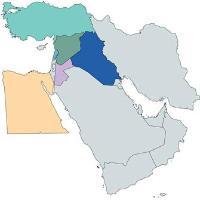 The current refugee crisis is a major international policy issue, with 79.5 million people being classified as refugees in 2019. Being able to effectively analyze refugee migration and behavior is necessary to provide support to both refugees and destination countries. Although past models have employed agent-based models, empirical models, or operations research models, there are few mechanistic models of refugee flow. We utilize a graph dynamical system approach; the graph’s structure models the geographical distribution of refugee populations, while the differential equations model the increase, decrease, and flow of refugee populations between regions. We apply the model to the Middle East and North Africa between 2006 and 2019, using data such as GDP, political stability, and environmental indices, and other predictors to calibrate the model’s parameters. Results shed light on the primary mechanisms that drive refugee migration and allow us to obtain refugee flow estimates where data is not available.
The current refugee crisis is a major international policy issue, with 79.5 million people being classified as refugees in 2019. Being able to effectively analyze refugee migration and behavior is necessary to provide support to both refugees and destination countries. Although past models have employed agent-based models, empirical models, or operations research models, there are few mechanistic models of refugee flow. We utilize a graph dynamical system approach; the graph’s structure models the geographical distribution of refugee populations, while the differential equations model the increase, decrease, and flow of refugee populations between regions. We apply the model to the Middle East and North Africa between 2006 and 2019, using data such as GDP, political stability, and environmental indices, and other predictors to calibrate the model’s parameters. Results shed light on the primary mechanisms that drive refugee migration and allow us to obtain refugee flow estimates where data is not available.
The dynamics of Delayed Onset Muscle Soreness: Mechanistic analysis based on the pharmacokinetics of creatine kinase and empirical assessment of risk of exertional rhabdomyolysis after long-distance running (2021)
Students: Jonah Jones
Adviser: Dr. Danilo Diedrichs
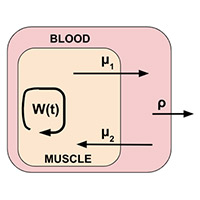 The mechanisms of Delayed onset muscle soreness (DOMS), the sensation of discomfort or pain in the skeletal muscles that occurs following unaccustomed muscular exertion, are poorly understood. There is evidence that DOMS is related to the release of creatine kinase from muscular tissue into the blood following muscular exertion. In some cases, DOMS may lead to exertional rhabdomyolysis (ER), a serious condition provoking muscle tissue breakdown and necrosis. Using data providing from self-reported DOMS in collegiate runners and long-distance racers from previous studies, we investigate the dynamics of DOMS using a mechanistic model which combines the dynamics of an overdamped harmonic oscillator with a compartment model for the pharmacokinetics of creatine kinase from its generation in muscle tissue through its elimination from the body. We then assess the risk of ER by a logistic regression based on creatine kinase levels and race distance. Results reveal the sources of variability in individual athletes’ response to DOMS, which may allow athletes and trainers to design more efficient training regimens and prevent the risk of ER.
The mechanisms of Delayed onset muscle soreness (DOMS), the sensation of discomfort or pain in the skeletal muscles that occurs following unaccustomed muscular exertion, are poorly understood. There is evidence that DOMS is related to the release of creatine kinase from muscular tissue into the blood following muscular exertion. In some cases, DOMS may lead to exertional rhabdomyolysis (ER), a serious condition provoking muscle tissue breakdown and necrosis. Using data providing from self-reported DOMS in collegiate runners and long-distance racers from previous studies, we investigate the dynamics of DOMS using a mechanistic model which combines the dynamics of an overdamped harmonic oscillator with a compartment model for the pharmacokinetics of creatine kinase from its generation in muscle tissue through its elimination from the body. We then assess the risk of ER by a logistic regression based on creatine kinase levels and race distance. Results reveal the sources of variability in individual athletes’ response to DOMS, which may allow athletes and trainers to design more efficient training regimens and prevent the risk of ER.
Analysis and suggestions for improvement in the Irish dance scoring and judging systems (2021)
Students: Willow Vander Kooi
Adviser: Dr. Danilo Diedrichs
 Competitive Irish dance has its own complex scoring system known as the Irish Points (IP) system, which involves the conversion of certified judges’ subjective “raw” scores into a relative rank, and finally into an IP score values via a nonlinear scale after a trimmed mean adjustment. The IP scores determine the placement of dancers at competitions, which ultimately determine the dancers’ overall ranking as well as professional opportunities. Our research analyzes both the IP system and the judging system. We identify the sources of loss of information and compare the IP system with alternate scoring systems based on semi-subjective judging used in other disciplines, such as figure skating, gymnastics, and dressage. We also identify several issues related to the judging system, including the scoring patterns of individual judges and variance between judges in a panel, thereby revealing sources of unfairness and potential judging errors. Finally, we suggest quality control strategies to identify potential sources of unfairness and error, as well as alternative systems that address the inherent weaknesses of the IP scoring and judging systems.
Competitive Irish dance has its own complex scoring system known as the Irish Points (IP) system, which involves the conversion of certified judges’ subjective “raw” scores into a relative rank, and finally into an IP score values via a nonlinear scale after a trimmed mean adjustment. The IP scores determine the placement of dancers at competitions, which ultimately determine the dancers’ overall ranking as well as professional opportunities. Our research analyzes both the IP system and the judging system. We identify the sources of loss of information and compare the IP system with alternate scoring systems based on semi-subjective judging used in other disciplines, such as figure skating, gymnastics, and dressage. We also identify several issues related to the judging system, including the scoring patterns of individual judges and variance between judges in a panel, thereby revealing sources of unfairness and potential judging errors. Finally, we suggest quality control strategies to identify potential sources of unfairness and error, as well as alternative systems that address the inherent weaknesses of the IP scoring and judging systems.
Sales Performance Analysis of Frito-Lay Route Sales Representatives in Knoxville, TN based on Social Network Analysis (2019)
Students: Christian Cameron, Chris Plimpton
Adviser: Dr. Danilo Diedrichs
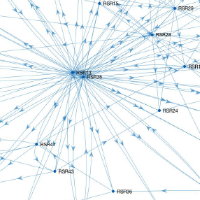 We analyze the sales performance of 41 Route Sales Representatives (RSR) at Frito Lay, Inc. in Knoxville (TN) using responses to survey questions concerning their levels of collaboration, trust, and communication with each other. We run a correlation analysis on the employee’s attributes and rankings, and use multiple regression with the employee’s sales performance as the dependent variable. We use graph theory to build an adjacency matrix for each social attribute, calculating every RSR’s degree, closeness, and betweenness, and determine the social network’s distance matrix. Results show that the sales teams grouped by supervisors have significantly different sales performance, and that that the degree to which an RSR is viewed as trustworthy is a significant predictor of sales performance.
We analyze the sales performance of 41 Route Sales Representatives (RSR) at Frito Lay, Inc. in Knoxville (TN) using responses to survey questions concerning their levels of collaboration, trust, and communication with each other. We run a correlation analysis on the employee’s attributes and rankings, and use multiple regression with the employee’s sales performance as the dependent variable. We use graph theory to build an adjacency matrix for each social attribute, calculating every RSR’s degree, closeness, and betweenness, and determine the social network’s distance matrix. Results show that the sales teams grouped by supervisors have significantly different sales performance, and that that the degree to which an RSR is viewed as trustworthy is a significant predictor of sales performance.
The Anti-Vaccination Movement’s Possible Deteriorative Effect on the Herd Immunity of Measles in a Major United States City (2019)
Students: Andy Holmberg, Jonathan Ward
Adviser: Dr. Danilo Diedrichs
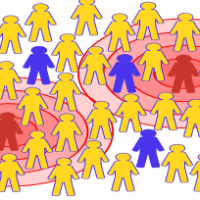 Rubeola, commonly known as the measles, is one of the most contagious viruses in the world. With more and more people opting out of the vaccine with the anti-vaccination movement, the possibility of outbreaks is becoming more of a concern. The goal of our project is to construct a mathematical model to study the spread of the disease. A major focus is finding parameters with an emphasis on the change in vaccination rates. A bifurcation analysis on the proportion of the population that is not vaccinated predicts the point at which herd immunity is lost. We focus on the immediate spread of the disease, assuming there will be few (if any) attempts to prevent and quarantine the spread. We conclude by examining the immediate threat of decreasing vaccination rates on the spread of measles. (Illustration: Herd Immunity by Tkarcher, Wikipedia, used under CC, modified from original.)
Rubeola, commonly known as the measles, is one of the most contagious viruses in the world. With more and more people opting out of the vaccine with the anti-vaccination movement, the possibility of outbreaks is becoming more of a concern. The goal of our project is to construct a mathematical model to study the spread of the disease. A major focus is finding parameters with an emphasis on the change in vaccination rates. A bifurcation analysis on the proportion of the population that is not vaccinated predicts the point at which herd immunity is lost. We focus on the immediate spread of the disease, assuming there will be few (if any) attempts to prevent and quarantine the spread. We conclude by examining the immediate threat of decreasing vaccination rates on the spread of measles. (Illustration: Herd Immunity by Tkarcher, Wikipedia, used under CC, modified from original.)
Impact of Immigration on Unemployment Rate and Per Capita GDP in U.S. States with a Large Immigrant Population (2019)
Students: Kailey Mulligan, Kiki Rogers
Adviser: Dr. Danilo Diedrichs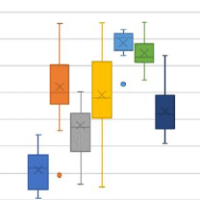 In the past decade, the United States has become home to millions of immigrants from around the world, one of the most debated issues today. This research analyzes the effect of immigration on unemployment and GDP per capita in the 17 states where immigrant population is at or above 10%. Using demographical data, correlation analysis and linear regression analysis reveal relationships between variables and the effect that a linear combination of these variables has on the unemployment rate and GDP per capita of each state. Principal component analysis allows us to simplify the predictors into one independent variable and determine an immigration index that can be applied to other states, cities, or counties.
In the past decade, the United States has become home to millions of immigrants from around the world, one of the most debated issues today. This research analyzes the effect of immigration on unemployment and GDP per capita in the 17 states where immigrant population is at or above 10%. Using demographical data, correlation analysis and linear regression analysis reveal relationships between variables and the effect that a linear combination of these variables has on the unemployment rate and GDP per capita of each state. Principal component analysis allows us to simplify the predictors into one independent variable and determine an immigration index that can be applied to other states, cities, or counties.
Quantifying the impact of health professionals on the short-term mental health of disaster victims through disaster response logistics (2017)
Students: Christy Baars, Sarah Denne
Adviser: Dr. Danilo Diedrichs
 While many disaster-planning programs consider how the transportation of material goods affects immediate fatalities following a natural disaster, fewer consider the effects of psychological trauma prevalent among survivors of disasters. The goal of our project is to integrate planning for short-term (3-12 weeks) counseling and mental health services into a disaster response logistics model to determine optimal strategies for deployment of psychological professionals on the ground.
While many disaster-planning programs consider how the transportation of material goods affects immediate fatalities following a natural disaster, fewer consider the effects of psychological trauma prevalent among survivors of disasters. The goal of our project is to integrate planning for short-term (3-12 weeks) counseling and mental health services into a disaster response logistics model to determine optimal strategies for deployment of psychological professionals on the ground.
Agent-based model of the spread of malaria in a refugee camp (2017)
Students: David Bakalemwa, David Gray
Adviser: Dr. Danilo Diedrichs
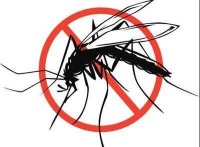 The spread of malaria, a deadly disease transmitted by mosquitoes in tropical and subtropical regions, can often become a problem in refugee camps. We model the spread of malaria in a refugee camp spatially and dynamically with an agent-based simulation. The concentration of mosquitoes is determined by solving a steady state diffusion boundary value problem. Agents have home locations and move semi-randomly throughout the day. The children’s movement patterns are based on their daily attendance at the refugee camp school to analyze the effect of school location on long-term infection rates among youths.
The spread of malaria, a deadly disease transmitted by mosquitoes in tropical and subtropical regions, can often become a problem in refugee camps. We model the spread of malaria in a refugee camp spatially and dynamically with an agent-based simulation. The concentration of mosquitoes is determined by solving a steady state diffusion boundary value problem. Agents have home locations and move semi-randomly throughout the day. The children’s movement patterns are based on their daily attendance at the refugee camp school to analyze the effect of school location on long-term infection rates among youths.
Mathematical model for student Zipcar demand at Wheaton College (2017)
Students: Michelle Chuang, Sara Magnuson
Adviser: Dr. Danilo Diedrichs
 The car-sharing business model has recently been brought to college campuses by companies like Zipcar. This project generates a model to predict Zipcar membership on Wheaton College's campus by class (freshmen, sophomore, junior, senior) using two cost functions to measure the cost of car-ownership and Zipcar membership. The model is calibrated by survey data regarding car-usage patterns on campus to compare the cost of car-ownership to Zipcar membership. These cost comparisons predict the demand for Zipcar membership and help determine if there is a market for Zipcar among each class at Wheaton College.
The car-sharing business model has recently been brought to college campuses by companies like Zipcar. This project generates a model to predict Zipcar membership on Wheaton College's campus by class (freshmen, sophomore, junior, senior) using two cost functions to measure the cost of car-ownership and Zipcar membership. The model is calibrated by survey data regarding car-usage patterns on campus to compare the cost of car-ownership to Zipcar membership. These cost comparisons predict the demand for Zipcar membership and help determine if there is a market for Zipcar among each class at Wheaton College.
Statistical and dynamical analysis of the relationship between crime rates and education in Cicero, Illinois (2017)
Students: Michaela Flitsch, Courtney Linscott, Mark Nussbaum
Adviser: Dr. Danilo Diedrichs
 Crime and education often have an inverse relationship: a low education level in a community correlates with a high crime rate. The south side of Chicago, notorious for high levels of crime and low levels of education, follows this trend. We use a correlation and multiple regression analysis with seven predictors to measure education and analyze its relationship with crime level in Cicero (IL) and surrounding areas. A dynamical analysis highlights the evolution of this relationship, and a hierarchical clustering analysis reveals geographical trends in the Chicagoland area. Our results suggest ways in which Cicero and similar communities can prioritize education to reduce their crime rate.
Crime and education often have an inverse relationship: a low education level in a community correlates with a high crime rate. The south side of Chicago, notorious for high levels of crime and low levels of education, follows this trend. We use a correlation and multiple regression analysis with seven predictors to measure education and analyze its relationship with crime level in Cicero (IL) and surrounding areas. A dynamical analysis highlights the evolution of this relationship, and a hierarchical clustering analysis reveals geographical trends in the Chicagoland area. Our results suggest ways in which Cicero and similar communities can prioritize education to reduce their crime rate.
Public Equitable Allocation of Resources Log (PEARL), an index and accounting tool for public accountability and equity in disaster response (2016)
Students: Claire Carlson, Kaile Phelps, Kyu Lim Lee, Daniela Cuba, Johnny Edman, Melissa Gray, Roland Hesse, Robin Kong, Samuel Takazawa
Adviser: Dr. Paul Isihara, Dr. David Boan, Dr. Danilo Diedrichs
 The need in disaster response to assess how reliably and equitably funding was accounted for and distributed is addressed by a standardized report and index applicable to any disaster type. Drawing from activity-based costing and the Gini index, a PEARL spreadsheet computes absolute inequity sector by sector as well as a cumulative index. Indices are useful to approximate proportions of inequity in the total response and investigate allocation under uncertainty in sector need specification. PEARL also assists historical analysis of all disaster types to determine completeness of public accounting records and equity in fund distribution. Data from the Nepal earthquake (2015), typhoon Haiyan (2013), the Haiti earthquake (2010), Sri Lankan flood (2011) and Hurricane Sandy (2012) are used for illustrative purposes.
The need in disaster response to assess how reliably and equitably funding was accounted for and distributed is addressed by a standardized report and index applicable to any disaster type. Drawing from activity-based costing and the Gini index, a PEARL spreadsheet computes absolute inequity sector by sector as well as a cumulative index. Indices are useful to approximate proportions of inequity in the total response and investigate allocation under uncertainty in sector need specification. PEARL also assists historical analysis of all disaster types to determine completeness of public accounting records and equity in fund distribution. Data from the Nepal earthquake (2015), typhoon Haiyan (2013), the Haiti earthquake (2010), Sri Lankan flood (2011) and Hurricane Sandy (2012) are used for illustrative purposes.
A mathematical model of gang membership in North Lawndale accounting for rehabilitation and fringe crime imprisonment (2015)
Students: Nate Annen, Jacob Clement
Adviser: Dr. Danilo Diedrichs, Dr. Noah Toly
 The community of North Lawndale is one of the most dangerous neighborhoods in the Chicago area. The crime rate is high and the gang life is prevalent. We use a compartment model consisting of four time-dependent nonlinear differential equations to describe how a gang evolves throughout the population of North Lawndale. Our research builds upon previous research, but accounting for population dynamics which were not previous considered such as the imprisonment of fringe crime and the rehabilitation of core gang members. The main findings of this research include conditions under which the core gang member population is notably reduced. Sensitivity analyses indicate which methods of reducing gang membership and crime rates are the most effective.
The community of North Lawndale is one of the most dangerous neighborhoods in the Chicago area. The crime rate is high and the gang life is prevalent. We use a compartment model consisting of four time-dependent nonlinear differential equations to describe how a gang evolves throughout the population of North Lawndale. Our research builds upon previous research, but accounting for population dynamics which were not previous considered such as the imprisonment of fringe crime and the rehabilitation of core gang members. The main findings of this research include conditions under which the core gang member population is notably reduced. Sensitivity analyses indicate which methods of reducing gang membership and crime rates are the most effective.
Exploratory analysis of a High-Speed Intercity Passenger Rail in the Midwest (2015)
Students: Miriam Agamah, Kyu Lim Lee
Adviser: Dr. Danilo Diedrichs

Many nations have developed extensive networks of high-speed passenger rails, such as France’s TGV rail network and Japan’s SCMaglev levitation train which recently (April 21, 2015) broke the rail speed record at 375 miles per hour. Currently the only high speed rail in the U.S. is the Acela Express linking Boston to Washington D.C. This study explores the financial feasibility and profitability of constructing a high speed rail between major cities in the Midwest. Using census data and the gravity model of trade, we estimate the transportation needs between promising city pairs over the next 50 years. We then conduct a comprehensive cost/benefit comparison between high speed rail, air and automobile transportation, using multinomial regression to quantify the attractiveness and ultimately estimate the ridership of the new railroad. We use data from the Acela express to estimate ticket prices, construction and maintenance costs to determine which lanes would generate a profit over the 50 year time horizon.
Clustering trends of overweight obesity in students in Dupage County (2015)
Students: Melissa Gray, Robin Kong
Advisers: Dr. Danilo Diedrichs, Dr. Nate Thom

Overweight and obesity are becoming more prevalent in elementary through high school students in the United States. This research analyzes trends of obesity and overweight among students in DuPage County Illinois to explore possible relationships between obesity and factors such as ethnicity, income, education level, or geographic location. Using data collected from over 200 area schools, hierarchical clustering algorithms show representative clustering of schools according to geographic location and the percentage of overweight or obese students in each school. Principal Component Analysis is used to determine factors contributing most to variability in the data. Ethnic distribution, average income, and average education level were explored within each cluster. These findings can contribute to the efforts to decrease overweight and obesity in students and predict future trends.
Agent-based simulation of crime in society (2015)
Students: Johnny Edman, Richard Ndekezi
Adviser: Dr. Danilo Diedrichs

Mathematical models are becoming increasingly common in the field of quantitative and predictive criminology. Previous modeling efforts have had some success using differential equations to determine the transition between different states using a modified SIR (Susceptible-Infected-Recovered) epidemiology model. However these models group a very diverse population in to a small number of compartments, thereby ignoring the individual behavior patterns and factors that determine crime. We use an Agent-Based Model (ABM) approach based on a computational random number generator to generate a virtual society of 1000 “agents”, each one having different characteristics including age, income level, educational attainment, ethnicity, gender and hostility based on realistic data-driven probability distributions. The ABM is embedded into a discrete dynamical model that tracks the evolution of each agent’s characteristics over a ten year time horizon, allowing us to determine which characteristic(s) are the most susceptible to induce crime in society.
Quantifying communication effects in disaster response logistics: A multiple network system dynamics model (2014)
Student: Kaile Phelps
Advisers: Dr. Danilo Diedrichs, Dr. Paul Isihara
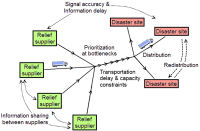 Complementing the importance of adequate relief supplies and transportation capacity in the first two weeks of post-disaster logistics, efficient communication, information sharing and informed decision-making play a crucial yet often underestimated role in reducing wasted material resources and loss of human life. A mathematical discrete dynamical system is used to model transportation of different commodities from multiple relief suppliers to disaster sites across a network of limited capacity with variable signal delays, information sharing, prioritization, distribution and redistribution strategies. Simulations results highlight how communication deficiencies and indiscriminate shipping of resources result in material convergence and shortage of urgent supplies observed in actual emergencies, thus providing a useful quantitative tool for decision-making and training volunteer managers in the importance of a smart response protocol.
Complementing the importance of adequate relief supplies and transportation capacity in the first two weeks of post-disaster logistics, efficient communication, information sharing and informed decision-making play a crucial yet often underestimated role in reducing wasted material resources and loss of human life. A mathematical discrete dynamical system is used to model transportation of different commodities from multiple relief suppliers to disaster sites across a network of limited capacity with variable signal delays, information sharing, prioritization, distribution and redistribution strategies. Simulations results highlight how communication deficiencies and indiscriminate shipping of resources result in material convergence and shortage of urgent supplies observed in actual emergencies, thus providing a useful quantitative tool for decision-making and training volunteer managers in the importance of a smart response protocol.
The Schedule Effect: can recurrent peak infections be reduced without vaccines, quarantines or school closings? (2013)
Student: Doeke Buursma
Advisers: Dr. Danilo Diedrichs, Dr. Paul Isihara
 Using a standard SIR (Susceptible-Infected-Recovered) model with seasonal dynamics, we study the "schedule effect", which allows for a significant reduction in recurrent peak infections of endemic diseases in schools by varying the traditional school calendar. Analysis of the phase plane explains the relationship between the maximum recurring infection peaks and the period of an oscillating transmission function. The response may exhibit period-doubling and chaos induced at certain periods, leading to increased peaks. We show how to take these effects into consideration to design an optimum school schedule.
Using a standard SIR (Susceptible-Infected-Recovered) model with seasonal dynamics, we study the "schedule effect", which allows for a significant reduction in recurrent peak infections of endemic diseases in schools by varying the traditional school calendar. Analysis of the phase plane explains the relationship between the maximum recurring infection peaks and the period of an oscillating transmission function. The response may exhibit period-doubling and chaos induced at certain periods, leading to increased peaks. We show how to take these effects into consideration to design an optimum school schedule.
A Mathematical Model for the Growth and Decline of the Church in DuPage County (2013)
Student: Daniela Cuba
Adviser: Dr. Danilo Diedrichs
 The project analyzes the population dynamics that affect size of the church in DuPage County, Illinois. A dynamic model (which we name the UEB model), similar to the SIR model used in epidemiology, divides the population into compartments of Unbelievers, Enthusiasts (who actively bring unbelievers into the church), and passive Believers. In addition to the conversion dynamics, our model also incorporates the long-term demographic fluctuations of DuPage County. The parameters of the model are determined by fitting church and demographic data obtained from the Census Bureau. The results of this study are useful to identify the most impactful strategies for churches to increase their membership.
The project analyzes the population dynamics that affect size of the church in DuPage County, Illinois. A dynamic model (which we name the UEB model), similar to the SIR model used in epidemiology, divides the population into compartments of Unbelievers, Enthusiasts (who actively bring unbelievers into the church), and passive Believers. In addition to the conversion dynamics, our model also incorporates the long-term demographic fluctuations of DuPage County. The parameters of the model are determined by fitting church and demographic data obtained from the Census Bureau. The results of this study are useful to identify the most impactful strategies for churches to increase their membership.
Constrained Optimization Model for Quantitative Criminology (2013)
Student: Korey Clement
Adviser: Dr. Danilo Diedrichs
 The constrained optimization model for quantitative criminology, first introduced by criminologists Alfred Blumstein and Daniel Nagin, is used to control and minimize the crime rate of a given population. Using the most recent data on crime and punishment available (2009), we use this model to determine the lowest crime rate that can achieved in the United States. The sensitivity analysis of the model's parameters reveals what steps must be carried forth in order to reduce the crime rate to a global minimum.
The constrained optimization model for quantitative criminology, first introduced by criminologists Alfred Blumstein and Daniel Nagin, is used to control and minimize the crime rate of a given population. Using the most recent data on crime and punishment available (2009), we use this model to determine the lowest crime rate that can achieved in the United States. The sensitivity analysis of the model's parameters reveals what steps must be carried forth in order to reduce the crime rate to a global minimum.
Development of an Application for Indoor Temperature Control Efficiency (2013)
Student: Roland Hesse
Adviser: Dr. Danilo Diedrichs
 Using numerical techniques to discretize and solve heat equation (a partial differential equation) in three dimensions, we devise a computerized application that models the heat flow and determines temperature gradients in a building. The application allows for the geometry of the rooms and insulation properties of the boundaries to be specified, as well as the indoor locations where people are most likely to be found. We use this system to locate the optimal placements of HVAC (Heating, Ventilation, and Air Conditioning) for overall efficiency in temperature control and reduction of wasted energy and climate-control costs.
Using numerical techniques to discretize and solve heat equation (a partial differential equation) in three dimensions, we devise a computerized application that models the heat flow and determines temperature gradients in a building. The application allows for the geometry of the rooms and insulation properties of the boundaries to be specified, as well as the indoor locations where people are most likely to be found. We use this system to locate the optimal placements of HVAC (Heating, Ventilation, and Air Conditioning) for overall efficiency in temperature control and reduction of wasted energy and climate-control costs.
Computational Composition of Traditional Scottish Music (2013)
Student: Tim Macdonald
Adviser: Dr. Danilo Diedrichs
 Traditional Scottish music has recurring patterns at the harmonic, melodic, and structural levels. Using a combination of automated pattern recognition techniques and domain-specific knowledge, we develop a system that, seeded with a corpus of existing tunes, composes original music in the same style. This is accomplished using a long short term memory network---a type of recurrent neural network. The corpus used was the complete works of 18th century composer William Marshall, which was transformed into a sequence of integers suitable for inputting into the network. Post-conversion, the music was used to train the network, and the trained network was used for generating new music.
Traditional Scottish music has recurring patterns at the harmonic, melodic, and structural levels. Using a combination of automated pattern recognition techniques and domain-specific knowledge, we develop a system that, seeded with a corpus of existing tunes, composes original music in the same style. This is accomplished using a long short term memory network---a type of recurrent neural network. The corpus used was the complete works of 18th century composer William Marshall, which was transformed into a sequence of integers suitable for inputting into the network. Post-conversion, the music was used to train the network, and the trained network was used for generating new music.
Inventory Models in Disaster Relief (2012)
Student: Nate Veldt
Adviser: Dr. Danilo Diedrichs
 Models for supply chain management can be used to assist humanitarian relief organizations in calculating how to efficiently provide for a population affected by a natural disaster. This project explores in detail a single period probabilistic model for fulfilling a demand while minimizing costs. The model is implemented in MATLAB and several examples are given of how this model might be used in a specific disaster relief situation. A Monte Carlo simulation is used to generate potential values for demand to then analyze how this model might be used to meet a demand that stretches over multiple periods.
Models for supply chain management can be used to assist humanitarian relief organizations in calculating how to efficiently provide for a population affected by a natural disaster. This project explores in detail a single period probabilistic model for fulfilling a demand while minimizing costs. The model is implemented in MATLAB and several examples are given of how this model might be used in a specific disaster relief situation. A Monte Carlo simulation is used to generate potential values for demand to then analyze how this model might be used to meet a demand that stretches over multiple periods.

